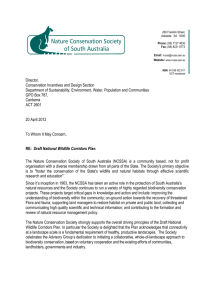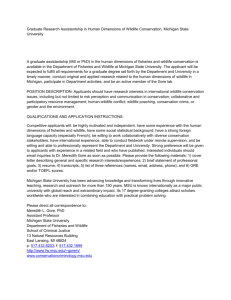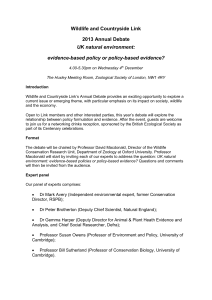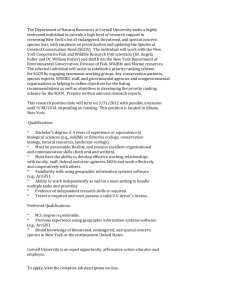Conservation Land Trusts Alliance
advertisement
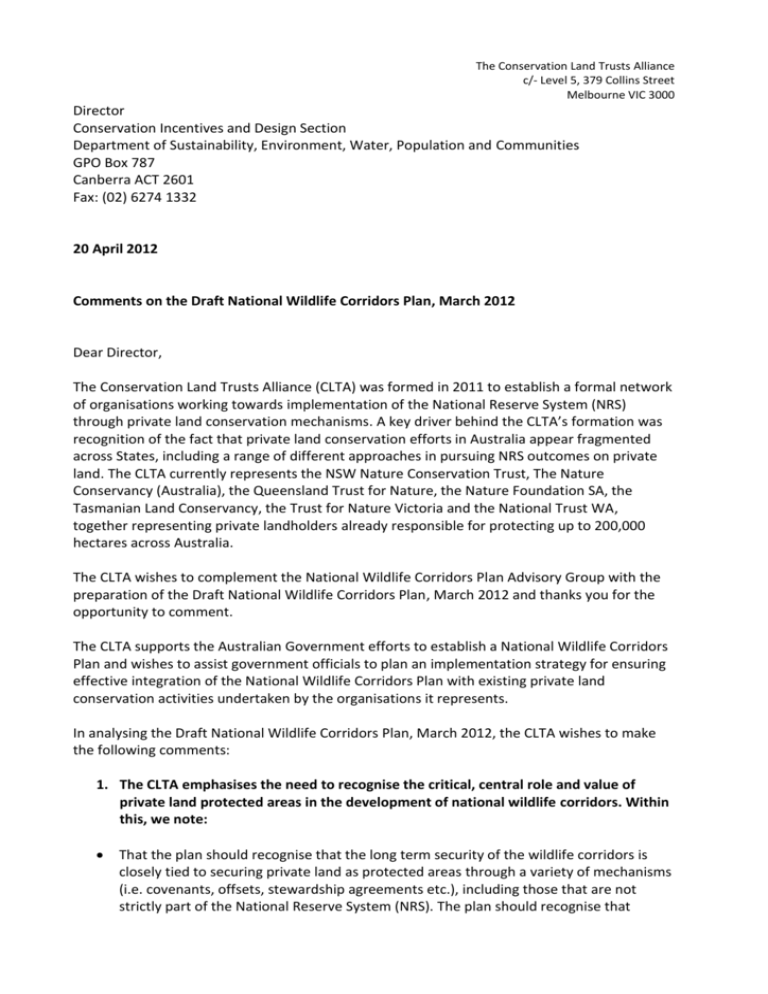
The Conservation Land Trusts Alliance c/- Level 5, 379 Collins Street Melbourne VIC 3000 Director Conservation Incentives and Design Section Department of Sustainability, Environment, Water, Population and Communities GPO Box 787 Canberra ACT 2601 Fax: (02) 6274 1332 20 April 2012 Comments on the Draft National Wildlife Corridors Plan, March 2012 Dear Director, The Conservation Land Trusts Alliance (CLTA) was formed in 2011 to establish a formal network of organisations working towards implementation of the National Reserve System (NRS) through private land conservation mechanisms. A key driver behind the CLTA’s formation was recognition of the fact that private land conservation efforts in Australia appear fragmented across States, including a range of different approaches in pursuing NRS outcomes on private land. The CLTA currently represents the NSW Nature Conservation Trust, The Nature Conservancy (Australia), the Queensland Trust for Nature, the Nature Foundation SA, the Tasmanian Land Conservancy, the Trust for Nature Victoria and the National Trust WA, together representing private landholders already responsible for protecting up to 200,000 hectares across Australia. The CLTA wishes to complement the National Wildlife Corridors Plan Advisory Group with the preparation of the Draft National Wildlife Corridors Plan, March 2012 and thanks you for the opportunity to comment. The CLTA supports the Australian Government efforts to establish a National Wildlife Corridors Plan and wishes to assist government officials to plan an implementation strategy for ensuring effective integration of the National Wildlife Corridors Plan with existing private land conservation activities undertaken by the organisations it represents. In analysing the Draft National Wildlife Corridors Plan, March 2012, the CLTA wishes to make the following comments: 1. The CLTA emphasises the need to recognise the critical, central role and value of private land protected areas in the development of national wildlife corridors. Within this, we note: That the plan should recognise that the long term security of the wildlife corridors is closely tied to securing private land as protected areas through a variety of mechanisms (i.e. covenants, offsets, stewardship agreements etc.), including those that are not strictly part of the National Reserve System (NRS). The plan should recognise that secure covenants and purchased areas are core to the success of habitat connectivity and landscape initiatives, and develop coordinated structures to support these activities. The plan should recognise the barriers to conservation on private lands (e.g. financial, legal, technical) and work to address these through coordinated, strategic activities. Development of national corridors will likely fail should these barriers be ignored. That the plan should ensure that areas to be recognised for special connectivity efforts are based around recognised biodiversity priorities, and include the development of an appropriate mechanism to help private landholders understand where and how their conservation contributions fit into the wildlife corridors and national conservation objectives. For instance, to which corridors and protected areas their land is or could be connected. On the basis that the program should also reflect and support the importance of private land conservation, this initiative should ensure that existing landowners who have already made a conservation commitment are, in turn, supported by this program. 2. The CLTA emphasises the need to recognise the important role that conservation organisations can play in initiating, promoting and supporting wildlife corridors that contain private land. Within this, we note: The plan should better recognise conservation organisations as being key partners in the development and delivery of any national, regional or local conservation programs, particularly for developing wildlife corridors that extend across catchments and state borders, where in some cases they are better placed than state NRM agencies to facilitate this work. The plan should recognise that the future security of wildlife corridors is closely tied to long term funding and management arrangements. CLTA member organisations are well placed to assist in this work, having extensive voluntary and philanthropic networks, long term stability, as well as extensive local private land conservation experience to support private landowners participating in the national wildlife corridors program and beyond. The plan should better reflect and further emphasise the important role that CLTA member organisations play in the development of the NRS, particularly their support and encouragement of landholders in their private land conservation efforts, and should include mechanisms to further support and strengthen these activities, including strategic coordination and funding arrangements. 3. The CLTA supports the promotion of wildlife corridors that improve ecological connectivity and promote conservation connectivity at all levels ranging from continental to national, regional and local. In this context, we: Emphasise that corridors should not be restricted to the current named corridors connectivity is important everywhere and there are some landscapes across Australia with significant high value biodiversity values and they should, in particular, be considered for investment beyond what is already in the plan. Emphasise the need for a strategic, long-term, whole of landscape approach that pertains to both private and publicly held lands that works from consistent and transparent principles with long-term measurable outcomes and objectives for wildlife corridors. Emphasise the need to strengthen the empirical body of data and understanding about the biodiversity and socio-economic effects of “wildlife corridors” in the landscape. Emphasise the need to establish a nationally-consistent conservation metric for monitoring, evaluation, reporting and verification on wildlife corridors, and for supporting adaptive wildlife corridor management, thereby further contributing to wildlife corridor sustainability and permanence. Emphasise the need to remove policy and legal barriers to the effective integration of relevant government programs pertaining to biodiversity conservation in Australia. 4. The CLTA supports the cooperative building of wildlife corridors that respect the existing rights of private landholders and benefit local communities. In this context, we: Emphasise the need for effective private landholder participation in wildlife corridor design and implementation in order to ensure optimised, multiple benefits that are equitable and sustainable. Support the inclusion of participatory mechanisms that capture scientific, traditional indigenous and practitioner knowledge and experience, particularly in the conceptualisation, design, implementation and sustained management of wildlife corridors. Emphasise the need to support, recognise and acknowledge the valuable role private land holders have played in conservation in Australia and the vital role they could play in wildlife corridor design, implementation and sustained management. Emphasise the need to not only increase community knowledge and understanding of wildlife corridors and connectivity conservation, but also address critical institutional, policy and legal barriers as well as capacity gaps that might negatively affect the implementation of wildlife corridors. Again, the CLTA would like to express its interest in working with government officials to address the above issues. In case you need any further clarification, please contact Stephen van der Mark or Mat Hardy (contact details on attached cover sheet). Yours Sincerely, Stephen van der Mark CEO Conservation Land Trusts Alliance
